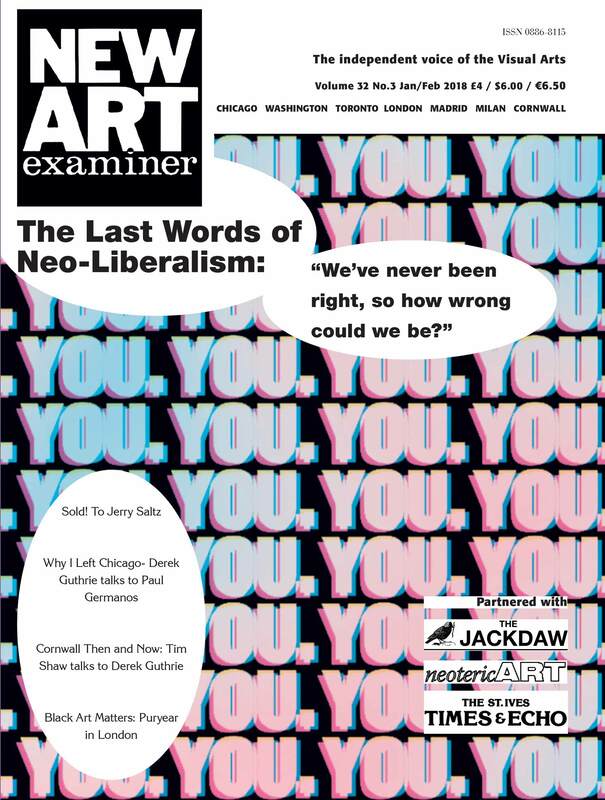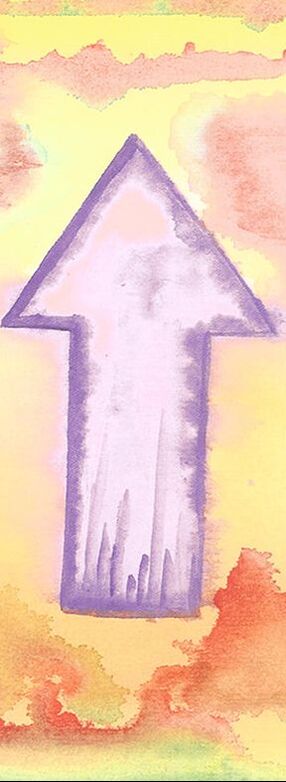|
Speakeasy by Dhyano Angius was Published in the New Art Examiner Volume 32 February 2018 When posed with the question, "What do you think about the Arts Market?", my response, paraphrasing Ghandi, would be: "I think that would be a good idea." Upon examination, it becomes apparent that what we commonly refer to as the Arts Market is nothing more than the commodification of creative expression. In order to sell a work of art, it must be stripped of its artistic value and instead imbued with a value that can be quantified in monetary terms. In reality, the Arts Market as we know it is simply a peripheral aspect of the larger market of goods. As a result, it operates under the same rules and yields the same effects. Only 1% of the artists in this market attract 99% of the capital available to the Arts, which includes art organizations and the gatekeepers who filter funds allocated to the Arts. So, what can be done to address this issue? In 2009, I proposed the New Futurist Manifesto, published by the St.Ives Times in Echo, exactly 100 years after the publication of the original Futurist Manifesto by Tommaso Marinetti. Despite being widely ignored, this manifesto remains relevant as we await the emergence of the new avant-gardes of the 21st century. While Futurism focused on the dynamicity within the work of art, the New Futurism is focused on the dynamicity of the work of art. The proposal is to abandon the narrow-minded existing Arts Market to those who wish to participate in it, and instead, to create new systems of distribution and exchange of works of art. Accelerating the circulation of the work of art is now imperative as the current system is slowing or even halting the circulation at its source. A significant number of works of art are currently stuck in artist studios and warehouses, deprived of the attention of potential audiences. The reason for this is simple: if gold were as abundant as pebbles, it would have no monetary value. If we were to devalue the 1% of works of art in the possession of wealthy collectors, they would stand to lose a significant amount of money. However, it is important to note that what they refer to as the Arts Market is not the existence of a true Arts Market, and this status quo will not endure. It is time to invent new ways to exchange and experience works of art, allowing 99% of excluded artists to access the 99% of excluded audiences. This will be the new avant-garde of the 21st century. |
Only 1% of the artists in this market attract 99% of the capital available to the Arts, which includes art organizations and the gatekeepers who filter funds allocated to the Arts. |
(Speakeasy di Dhyano Angius Pubblicato su New Art Examiner febbraio 2018 Se mi venisse posta la domanda: "Cosa pensi del mercato dell'arte?", risponderei, citando Ghandi, con le stesse parole che ha utilizzato lui quando gli è stato chiesto della civiltà occidentale. "Penso che sarebbe una buona idea." Se guardo fuori, non vedo una cosa come un mercato dell'arte. Quello che generalmente chiamiamo mercato dell'arte non è altro che la mercificazione di un'attività creativa. L'unico modo per vendere un'opera d'arte è privarla di tutti i valori artistici e investirla con un altro valore. È quel valore che può essere quantificato in forma monetaria, non il valore artistico intrinseco dell'opera d'arte. In realtà, il mercato dell'arte come lo conosciamo è solo un'attività periferica del più ampio mercato dei beni. Per questo motivo, assume le stesse regole e, di conseguenza, gli stessi effetti: solo l'1% degli artisti in questo mercato attrae il 99% del capitale disponibile per le arti e questo include le organizzazioni artistiche o meglio le "organizzazioni di impiegati" che filtrano i denari disponibili per le arti. Allora, cosa possiamo fare al riguardo? Nel 2009 ho elaborato il Nuovo Manifesto Futurista pubblicato dal St.Ives Times in Echo esattamente 100 anni dopo la pubblicazione del Manifesto Futurista originale di Tommaso Marinetti. Il Nuovo Manifesto Futurista è stato ampiamente ignorato come tutte le idee rivoluzionarie non supportate da un movimento. (Lo potete sentire nel podcast 'Nomenclature Parallele') Tuttavia, il manifesto è ancora valido, poiché stiamo ancora aspettando che arrivino le nuove avanguardie del 21° secolo. Se il Futurismo si concentrava sulla dinamicità ALL'INTERNO dell'opera d'arte, il Nuovo Futurismo si concentra sulla dinamicità DELL'opera d'arte. L'idea è quella di abbandonare il cosiddetto 'mercato dell'arte' esistente, a se stesso e a chiunque voglia giocare al gioco del Monopoly con esso. Semplicemente abbandoniamolo, come facciamo con i rifiuti spaziali. Invece, si diriga l' attenzione verso un nuovo mercato, bypassando le organizzazioni artistiche manipolatrici e le gallerie nazionali e private che non solo rallentano ma fermano la circolazione dell'arte alla sua fonte. Un numero significativo di opere d'arte sono attualmente bloccate negli studi degli artisti e nei magazzini, private dell'attenzione del pubblico potenziale. La ragione di ciò è semplice: se l'oro fosse abbondante come i sassolini, non avrebbe alcun valore monetario. Se decidessimo di svalutare l'1% delle opere d'arte in mano ai ricchi collezionisti, perderebbero una considerevole quantità di denaro. Tuttavia, è importante notare che ciò che loro chiamano Mercato dell'Arte non è l'esistenza di un vero Mercato dell'Arte e questo status quo non durerà. È tempo di inventare nuovi modi per scambiare e esperire le opere d'arte, permettendo al 99% degli artisti esclusi di accedere al 99% del pubblico esclusi. Questa sarà la nuova avanguardia del 21esimo secolo. |

